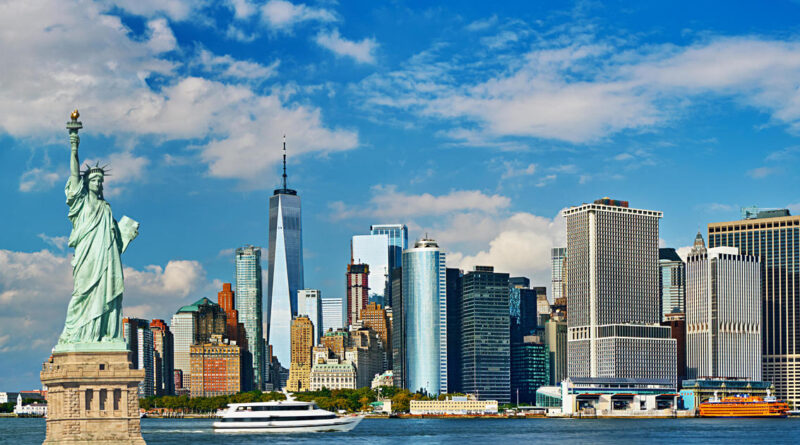History of New York City
New York City, often referred to as the “Big Apple,” is one of the most iconic cities in the world. Its history is a rich tapestry of cultural diversity, economic power, and social evolution that has shaped not only the United States but also the global landscape. From its early days as a Dutch colony to its current status as a global financial hub, New York City’s past is filled with stories of innovation, resilience, and transformation.
Pre-Colonial Era and Native American Inhabitants
Long before European explorers arrived, the area now known as New York City was inhabited by the Lenape people. The Lenape, part of the Algonquin language group, lived in small, semi-permanent settlements scattered across the region. They relied on the rich natural resources of the area, including rivers, forests, and coastal waters, for hunting, fishing, and farming. Their culture was deeply connected to the land, with spiritual beliefs centered around the natural world. The Lenape’s way of life would be drastically altered with the arrival of European settlers in the 17th century.
European Discovery and Early Explorations
The first recorded European to explore the area was the Italian navigator Giovanni da Verrazzano, who arrived in 1524. However, it was Henry Hudson’s 1609 voyage under the Dutch flag that marked the beginning of European interest in the region. Hudson’s exploration of the river that now bears his name opened the door for Dutch colonization. The strategic location of New York Harbor made it an attractive site for trade, and the Dutch West India Company soon established a foothold in the area.
Dutch Colonization: New Amsterdam (1624-1664)
In 1624, the Dutch established the colony of New Netherland, with New Amsterdam on Manhattan Island as its capital. The settlement served as a major trading post for the Dutch West India Company, dealing primarily in fur. The colony’s early years were marked by competition with Native American tribes, as well as other European powers. The Dutch laid the foundations of the city’s future growth by introducing a grid system for streets, establishing trade routes, and building fortifications. Despite these early efforts, the colony remained relatively small and was often overshadowed by other Dutch holdings.
English Takeover and the Birth of New York (1664-1783)
In 1664, during the Second Anglo-Dutch War, English forces captured New Amsterdam without much resistance. The English renamed the city New York in honor of the Duke of York, who later became King James II. Under English rule, New York began to grow rapidly. The city’s population swelled as more immigrants arrived, attracted by the opportunities in trade and commerce. The English also introduced new legal and administrative systems, which helped to solidify New York’s role as a major colonial port. By the mid-18th century, New York was one of the largest and most important cities in the American colonies.
New York During the American Revolution (1775-1783)
New York City played a pivotal role during the American Revolution. Initially, the city was a stronghold for British forces after General George Washington’s retreat from the Battle of Long Island in 1776. New York remained under British control for much of the war, serving as a base for military operations. The city’s residents experienced the hardships of occupation, including the Great Fire of 1776, which destroyed much of the city. However, the end of the war in 1783 marked a new beginning for New York, as the British evacuated the city, and it became the first capital of the United States under the Articles of Confederation.
Post-Revolutionary Growth and the Erie Canal (1783-1825)
The years following the American Revolution were a period of rapid growth for New York City. The city’s population and economy expanded as it became a major center for trade and finance. One of the most significant developments during this time was the construction of the Erie Canal, completed in 1825. The canal connected the Great Lakes to the Atlantic Ocean, making New York the primary gateway for goods moving between the Midwest and Europe. This new trade route brought immense wealth to the city and spurred further urban development, establishing New York as the nation’s commercial capital.
The Great Immigration Wave and Urbanization (1820-1890)
The 19th century saw a massive influx of immigrants to New York City, with millions arriving from Europe, particularly Ireland, Germany, and later Southern and Eastern Europe. These new arrivals settled in neighborhoods such as the Lower East Side, where they lived in crowded tenements under often harsh conditions. The city’s infrastructure struggled to keep up with the rapid population growth, leading to significant challenges in housing, sanitation, and public health. Despite these difficulties, the immigrants brought diverse cultures, languages, and traditions, which enriched the city’s social fabric and laid the foundation for its multicultural identity.
The Gilded Age and the Rise of Industry (1870-1900)
The period following the Civil War, known as the Gilded Age, was marked by rapid industrialization and economic growth in New York City. This era saw the rise of powerful industrialists like John D. Rockefeller and Andrew Carnegie, who amassed vast fortunes and built some of the most iconic buildings in the city. Skyscrapers began to dominate the skyline as New York became the financial center of the United States. However, this wealth was accompanied by significant social inequalities, with a stark contrast between the lavish lifestyles of the wealthy and the poverty experienced by the working class.
The Progressive Era and the Labor Movement (1890-1920)
In response to the social issues that arose during the Gilded Age, the Progressive Era brought about significant reforms in New York City. The labor movement gained momentum as workers organized strikes and demanded better wages, working conditions, and hours. The Triangle Shirtwaist Factory fire in 1911, which killed 146 workers, highlighted the need for workplace safety regulations and led to major changes in labor laws. During this period, women’s suffrage also gained ground, with New York playing a key role in the fight for women’s rights. The city’s political landscape began to shift as progressive ideas took hold, leading to greater social and economic justice.
The Roaring Twenties and the Great Depression (1920-1939)
The 1920s were a time of great cultural and economic prosperity for New York City. Known as the Roaring Twenties, this decade saw the rise of jazz, the Harlem Renaissance, and a booming stock market. The city’s nightlife thrived, with speakeasies, theaters, and clubs attracting people from all walks of life. However, this period of prosperity came to a sudden end with the stock market crash of 1929, which plunged the city and the nation into the Great Depression. Unemployment soared, and many New Yorkers struggled to survive during this challenging time. The New Deal programs of the 1930s, initiated by President Franklin D. Roosevelt, provided some relief and helped to rebuild the city’s economy.
World War II and Post-War Prosperity (1939-1960)
World War II brought significant changes to New York City, as it became a hub for military and industrial activity. The city’s ports were crucial for the war effort, and many New Yorkers contributed to the fight overseas. After the war, the city experienced a period of unprecedented prosperity. The post-war economic boom led to the expansion of the middle class, suburbanization, and the growth of industries such as finance, media, and entertainment. The United Nations headquarters was established in New York in 1945, further cementing the city’s status as a global center of diplomacy and international relations.
The Civil Rights Movement and Social Change (1950-1970)
The Civil Rights Movement of the 1950s and 1960s had a profound impact on New York City. The city was a focal point for activism, with significant events such as the March on Washington for Jobs and Freedom in 1963. New Yorkers played a vital role in the fight for racial equality, and the city became a center for the African American civil rights movement. The era also saw the rise of the women’s liberation movement, LGBTQ+ rights activism, and other social justice causes. The cultural landscape of New York was forever changed as these movements brought about greater awareness and progress toward equality.
Economic Decline and the 1970s Fiscal Crisis
The 1970s were a challenging decade for New York City, marked by economic decline, rising crime rates, and a fiscal crisis that nearly led to bankruptcy. The city’s manufacturing base continued to shrink, and unemployment rates soared. The fiscal crisis reached its peak in 1975 when the city was forced to ask for federal assistance to avoid defaulting on its debts. The famous New York Daily News headline “Ford to City: Drop Dead” captured the mood of the time, reflecting the federal government’s initial reluctance to provide aid. Eventually, a financial rescue plan was implemented, but the city was left scarred by the crisis, with deep cuts to public services and a sense of decline that lingered for years.
Rebirth and the Financial Boom of the 1980s and 1990s
Despite the challenges of the 1970s, New York City began to recover in the 1980s. The financial sector led the city’s economic resurgence, with Wall Street becoming the driving force behind a new era of prosperity. The real estate market boomed, and the city experienced a wave of gentrification, particularly in neighborhoods like SoHo and the East Village. The 1990s saw the election of Mayor Rudy Giuliani, who implemented policies aimed at reducing crime and revitalizing the city’s image. By the end of the 20th century, New York had regained its status as a thriving global metropolis, attracting people from around the world to its vibrant cultural scene and economic opportunities.
The Impact of 9/11 and the Resilience of New York City
The terrorist attacks of September 11, 2001, were a defining moment in New York City’s history. The attacks, which brought down the Twin Towers of the World Trade Center, resulted in the loss of nearly 3,000 lives and left a lasting impact on the city and the nation. In the aftermath, New Yorkers demonstrated remarkable resilience, coming together to rebuild and recover. The city has since transformed the site of the attacks into a memorial and a symbol of hope and resilience. The rebuilding of Lower Manhattan, including the construction of the new One World Trade Center, has been a testament to the city’s enduring spirit.
21st Century New York: A Global Metropolis
In the 21st century, New York City continues to evolve as a global metropolis. The city has embraced technological innovation, becoming a hub for the tech industry alongside its traditional strengths in finance, media, and the arts. The population has continued to grow, with new waves of immigrants adding to the city’s rich cultural tapestry. However, New York also faces ongoing challenges, including issues related to housing affordability, income inequality, and climate change. The COVID-19 pandemic, which hit the city hard in 2020, brought new challenges, but New York’s ability to adapt and recover has once again demonstrated its resilience.
Conclusion
The history of New York City is a story of constant change and reinvention. From its early days as a Dutch trading post to its current status as one of the most influential cities in the world, New York has always been at the forefront of economic, cultural, and social developments. Its legacy is one of diversity, innovation, and resilience, and its future promises to be just as dynamic. As New York City continues to grow and evolve, it remains a beacon of opportunity and a symbol of the American dream.
Discover more from City Towner
Subscribe to get the latest posts sent to your email.




